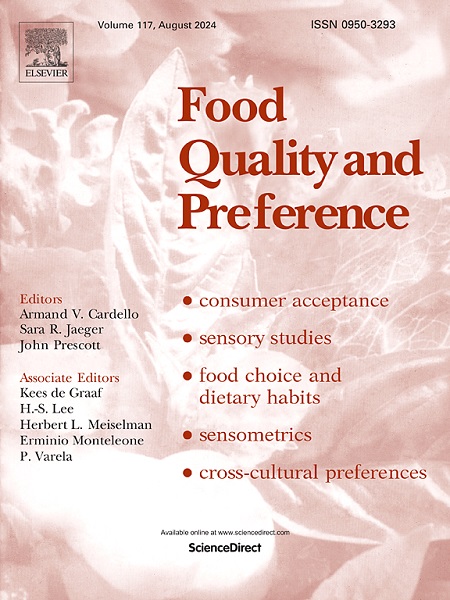Impact of five basic tastes perception on neurophysiological response: Results from brain activity
IF 4.9
1区 农林科学
Q1 FOOD SCIENCE & TECHNOLOGY
引用次数: 0
Abstract
The five basic tastes (sweet, salty, umami, sour, and bitter) perception plays a fundamental role in food choices. Nevertheless, how the perception of each basic tastes influence brain activity is still unknown. We investigated the effect of each taste on the brain activity of healthy adults using electroencephalography (EEG). For that, sucrose, sodium chloride, sodium glutamate, citric acid, and caffeine solutions were individually administered to 28 participants (18–25 years old). Self-reporting feedback was assessed using the 3-dimensional Self-Assessment-Manikin (SAM). The power density of the five frequency bands (delta, theta, alpha, beta and gamma) computed from the EEG signals was used to compare the five basic tastes. Significant differences (p < 0.05) were found for (1) beta waves: sweet vs umami, and salty vs umami; and for (2) gamma waves: sweet vs umami, and sweet vs bitter. The findings also indicate that sweet taste stimulated higher brain activity than umami in the gamma but not in the beta waves. Sweet, salty, umami and bitter tastes correlated with SAM responses. This study advances the understanding of brain response to taste stimuli, whilst improving the knowledge of these sensorial cognitive processes. Clinical trial Identifier: NCT06051175
五种基本味觉感知对神经生理反应的影响:来自大脑活动的结果
五种基本口味(甜、咸、鲜、酸、苦)的感知在食物选择中起着基本的作用。然而,对每种基本口味的感知如何影响大脑活动仍然未知。我们利用脑电图(EEG)研究了每种口味对健康成人大脑活动的影响。为此,蔗糖、氯化钠、谷氨酸钠、柠檬酸和咖啡因溶液被分别给予28名参与者(18-25岁)。采用三维自我评估模型(SAM)对自我报告反馈进行评估。从脑电图信号中计算出的五个频段(delta、theta、alpha、beta和gamma)的功率密度被用来比较五种基本味觉。显著差异(p <;(1) β波:甜味vs鲜味,咸味vs鲜味;对于(2)伽马波:甜对鲜,甜对苦。研究结果还表明,甜味比鲜味更能刺激大脑的伽马波活动,而不是β波。甜味、咸味、鲜味和苦味与SAM反应相关。这项研究促进了对大脑对味觉刺激反应的理解,同时提高了对这些感官认知过程的认识。临床试验编号:NCT06051175
本文章由计算机程序翻译,如有差异,请以英文原文为准。
求助全文
约1分钟内获得全文
求助全文
来源期刊

Food Quality and Preference
工程技术-食品科技
CiteScore
10.40
自引率
15.10%
发文量
263
审稿时长
38 days
期刊介绍:
Food Quality and Preference is a journal devoted to sensory, consumer and behavioural research in food and non-food products. It publishes original research, critical reviews, and short communications in sensory and consumer science, and sensometrics. In addition, the journal publishes special invited issues on important timely topics and from relevant conferences. These are aimed at bridging the gap between research and application, bringing together authors and readers in consumer and market research, sensory science, sensometrics and sensory evaluation, nutrition and food choice, as well as food research, product development and sensory quality assurance. Submissions to Food Quality and Preference are limited to papers that include some form of human measurement; papers that are limited to physical/chemical measures or the routine application of sensory, consumer or econometric analysis will not be considered unless they specifically make a novel scientific contribution in line with the journal''s coverage as outlined below.
 求助内容:
求助内容: 应助结果提醒方式:
应助结果提醒方式:


